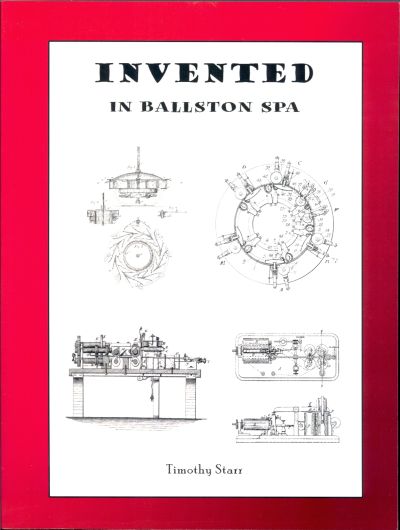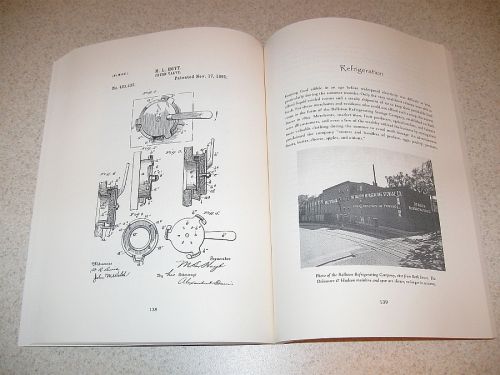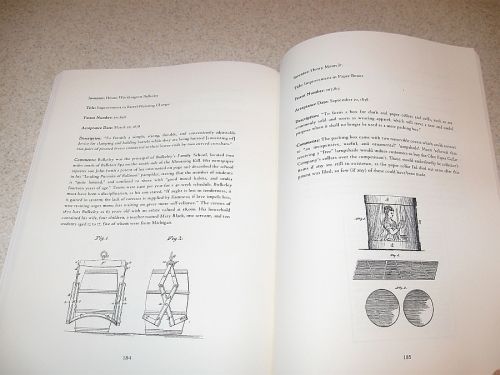|
A History of its Industries,
Railroads and Inventions
|
Invented In Ballston Spa
|
"Invented In Ballston Spa" focuses primarily on the industrial-related inventions of the nineteenth century, although many others are also described. The book was released in April 2008, and is for sale at the Brookside Museum, 6 Charlton Street, Ballston Spa. The industrial-related inventions of Ballston Spa were arguably the most successful. Patents were filed for paper-making, churns, hard edge tools, textiles, water wheels, and tanning leather. The most important patents are reproduced in their entirety in the book. The second section, titled "Consigned to History," summarizes dozens of other inventions that may or may not have related to industry. A graphic from the patent drawing accompanies each one. Although not every invention could be included, many of the most famous, unique, or bizarre patents are represented, including many by well-known Ballstonians. Note: this book is out of print (2011). |
|
Table Of Contents |
|
|
|
|
|
Introduction |
1 |
|
Knitting |
5 |
|
Hard Edge Tools |
25 |
|
Telegraphs |
47 |
|
Paper Products |
62 |
|
Water Wheels |
100 |
|
Tanning Leather |
115 |
|
Churns |
127 |
|
Refrigeration |
139 |
|
Textiles |
146 |
|
Consigned to History |
167 |
Excerpt from the Introduction (copyright 2008, Timothy Starr):
Ballston was at one time home to an industrial complex that far outweighed the level of its population and geographic size. During the latter 1800s, the town shipped hard-edged tools around the world, had one of the country’s largest tanneries, produced a renowned water wheel, revolutionized knitting machines, and produced 70 percent of the world’s manila paper. In a village that contained just a few thousand inhabitants from 1850 to 1950, almost 200 patents were filed with the United States Patent Office, most in support of the industry. In conducting patent searches of other comparable villages during this time period, it is evident that this number of inventions by such a small number of people is remarkable. Only the much larger villages of Saratoga Springs and Waterford were home to more patents than Ballston Spa in Saratoga County.
It is doubtful that the earliest settlers of Ballston would have guessed that within 50 years the village would be the center of a significant manufacturing center that would ship goods around the world. In the late 1700s, the idea would have seemed far-fetched, to say the least. For many years after the initial discovery of a mineral spring by surveyor Beriah Palmer, the “village” consisted of a small clearing with no permanent settlers. Only in 1783 did a man named Jonathan Peckam establish a home site on present-day Pleasant Street. It took another four years for a one-story tavern to be erected for the accommodation of guests. The only industry that was established in the early years were those that directly served local residents. However, as each year passed and more visitors made the journey to the growing settlement in search of a cure for their ailments, it became more and more likely that one of them would be an entrepreneur who noticed the possibilities of the Kayaderosseras and Gordon creeks near the Iron Railing Spring. After Nicholas Low built the famous Sans Souci hotel, further settlement ensued, and the village was incorporated in 1807.
Once a permanent population had been established to provide a stable workforce, industry could be developed. At first this consisted of sawmills which furnished the lumber needed to build the new boarding houses and dwellings, and gristmills for grinding grain into flour. However, within a short period of time, the village built the “Academy” (one of only 48 academies in the state at that time), a firehouse, stores, and hotels. More significantly, several manufacturing sites were established that would soon prove to be far more profitable and reliable than the seasonal tourist trade could ever be.
Ballston Spa has always been proud of its industrious and enterprising citizens. The wealthiest and most successful individuals such as George West, Isaiah Blood, and Nicholas Low receive the most fame, but there are many others who have been immortalized in local histories, documents, and speeches. In his centennial address of 1907, Village President Irving Wiswall summarized the accomplishments of some of the most famous residents:
The first paper bags were made in this village, and the first paper collars and cuffs were made by L. M. Crane, who lived here, his mill being located about two miles north of the village. Timothy Bailey, the inventor of the knitting machine which revolutionized that business, was one of our respected citizens. The telegraph instrument in universal use today and which supplemented the original Morse machines, was the invention of our townsman, Samuel F. Day, who also discovered the method of telegraphing with safety during thunderstorms. The first machine for making paper bags was invented in our village, and the first machine for combining paper with cloth was the invention of one of the proprietors of the Glen Paper Collar Company. The first household clothes-wringers were made in West Milton and sold in Ballston Spa.
This book
is an attempt to preserve the accomplishments of these and other
inventors throughout Ballston’s history. The ground-breaking patents of
Crane, Bailey, Day, and Medbery noted above, as well as many others, are
reproduced here in their entirety. Each section contains an introduction
and a summary of the inventors, and in many cases what may have
motivated them to create their inventions in the first place. The second
part of the book (“Consigned to History”) summarizes 30 more inventions.
It is hoped that through this compilation, a greater appreciation for
Ballston’s place in history can be learned.

TOPIX On-line community Ballston Spa, NY Wednesday May 21, 2008 Timothy Starr "Un-Earths" the Invention History of Ballston Spa By Drew Chapman Local author and history buff Timothy Starr has discovered great inventions in doing research for his local books, “Invented in Saratoga County,” slated for a July release is a step up from "Invented in Ballston Spa" released in April. All four of his books have been self-published. Among those Ballston Spa-borne inventions were well-known developments like Samuel Day’s improvements on telegraph design or George West’s square-bottomed paper bag. Starr’s research actually discovered evidence that West was indeed the originator of the bag, not his nephew James, whose name appears on the patent. Benjamin Barber developed a water wheel, patented in 1870, that was hailed as a revolutionary design. The invention was created out of need — Barber put his first wheel to work at his lumber yard before exporting them across the country. Then there are the inventions that Starr files under his aptly-titled chapter “Consigned to History.” Ivy Howell patented a bathroom sign designed to point the sexes in the proper direction. Emory Tiffault invented a bottle cap remover, and the first household clothes wringers were made by Benjamin Smith in West Milton. In 1859, Theodore Lipshuts patented his device that randomly discharged a firearm as a “Self-Acting Battery for Scaring Crows.” |




To purchase a book by mail, click here
[Home]
